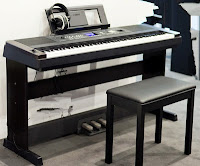 |
| Yamaha DGX660 Black |
UPDATED REVIEW – February 21, 2017: The Yamaha DGX640 was replaced by the DGX650, which has now been replaced by the new 2016 DGX660. Like the DGX640 and DGX650 before it, the DGX660 comes with the stand although the 3-pedal unit and bench are optional and at additional cost. The new 2016 DGX660 is available in an attractive black or white cabinet finish instead of the old fashioned wood tone finishes and the piano sound & digital features (along with connectivity) is upgraded for around the same selling
price as the DGX650 before it. Also, the higher priced ($1999 internet price) furniture cabinet
model YDPV240 is basically the same piano as the much older and less expensive discontinued DGX640 except in a more traditional furniture cabinet with a better
internal speaker system. I don’t recommend buying the YDPV240 at this point until
that model is discounted from its regular $1999 internet price and comes down in price as it will likely be
replaced soon (based on my experience of when these things happen) by a new model. I
don’t have any actual info on the replacement model number or price for the eventual replacement of the YDPV240, but it should be soon.
| Yamaha YDPV240 |
I do recommend the Yamaha DGX660, YDPV240, and YDP181 digital pianos, assuming the YDPV240 price comes down, and I suspect the YDP181 will also be discontinued fairly soon because it has been out for awhile. The YDPV240 & DGX660 are designed to give beginners and recreational piano players a good selection of automatic accompaniment rhythm styles along with some fun educational features that can be helpful for piano practice. The YDP181 is overall a basic digital piano when it comes to what it offers and the lower priced Yamaha YDP143 and
YDP163 are new models and the YDP181 did not have any upgrades so in some ways the new lower priced models are better than the higher priced YDP181.
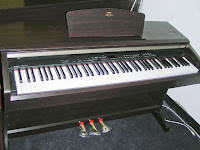 |
| Yamaha YDP181 |
Yamaha has been a well known and respected name in the music industry and it is well deserved. The YDP-V240 (top left pic) is internet priced at $1999, the YDP181 (middle left pic) is selling for $1699, and the new DGX660 is selling for a new lower price of $799 (incl stand). The YDPV240 and DGX660 still uses the basic lighter weight GHS key action which is less like a real piano key action. I have played this key action many times on various lower
priced Yamaha digital pianos and although the action feels good overall for a digital piano,
it is a bit noisy with some occasional rattles & shakes (plastic sounding), and not as quiet or solid of a feel as the Yamaha GH
action found in the YDP181. However the YDP181 key action is overly stiff when pressing the keys down and not as enjoyable to play as other brands and models I have played.
| DGX660 |
The YDPV240 and DGX660 have all “the bells and
whistles” on them incl multi-track general MIDI recording a playback
with USB flashdrive input feature that can be fun for piano students and
recreational players. These two models also have hundreds of cool
instrument sounds, drum rhythms, one finger automatic chord styles, and
other interactive features which some people use and some do not.
However, the YDPV240 is over $1000 more than the DGX660 (when optional
pedals & bench are added) which in my opinion makes the very V240
overpriced for what you’re getting. Yes, it does have a more traditional cabinet with more powerful internal speaker system than the portable DGX660, but not enough to justify
the price. The key action movement of the both the YDPV240 & DGX660 is also not as robust as the
YDP181. The YDP181 has 128-note polyphony along with a heavier
& quieter key action movement, bu the new DGX660 has 192-note polyphony which makes the DGX660 better in that way.
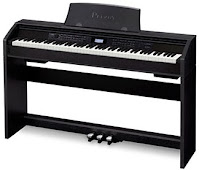 |
| Casio PX780 Piano |
The
Yamaha YDPV240 along with the DGX660 does some very cool stuff, but the Casio company has digital pianos that are using
a newer 3-senor keytouch system with a hammer style mechanism to give a
smoother acoustic upright piano response and sound with a more natural key
movement in my opinion. So when it comes to piano polyphony, piano tone,
and key action, the YDPV240 could have been better, but it is a lot of
fun and does some cool tricks. If Yamaha had a much lower price on the
YDPV240 closer to that of the popular Casio PX780, then no doubt it be a much
better value and a closer competitor.
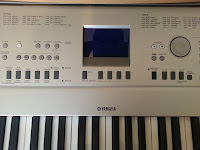
But
no matter what, in most cases the “piano playing experience” is personal
and subjective as it should be, so you can have a great time with all
of these models depending on what you want. However, the Yamaha V240 is
internet priced at $1000 more than the new Casio PX780, which is a huge difference, so that price difference alone makes the new Casio a much better buy in my opinion. I would recommend you also check out my Casio PX780 review: Casio PX780 review

As
far as the Yamaha YDP181 goes, it’s really quite basic (same cabinet
& sound system as the V240) and has almost none of the functions
of either the Yamaha DGX660 or YDPV240. But it was not built for that purpose
as it’s goal is to give you a good replacement for an upright
piano which is what it tries to do, and is certainly much better in that
way than the other two Yamaha pianos. However the YDP181 does not have a
USB ipad/computer output connection on it which is a big drawback in my
book. Even the YDPV240 and DGX660 has the USB connector although it is
not the new “plug & play” system that Casio pianos have
which is even better and make interactive play with an iPad more
intuitive. I can provide you with more iPad digital piano info if you contact me.
With regard to Casio in the lower price range
right now, they have their very popular AP460 digital piano which at just
$1499 internet discount price is $200 less than the Yamaha YDP181 and easily competes with it with even more advanced features. The AP460 has 256-note polyphony (allows for an even more realistic piano playing experience), 40 watt 4-speaker sound system, synthetic ivory & ebony keys for very nice key surface, and many other cool features including high speed USB direct connection to iPad for educational apps (I use them all the time for teaching and notation). Yamaha does have the more popular name in pianos
(they make great acoustic grands & uprights), but the name isn’t
what you will be playing…it’s the piano itself. With that in mind,
check out the Casio models at the following review: Casio AP460 review
Also, the Casio PX780 ($999 internet price) would be a great alternative to the DGX660 in terms of key action realism, piano sound, internal sound system, and a few other features, and competes head on with the Yamaha YDPV240, but for half the price. Go to the following link to read my review on the Casio Privia PX780: Casio PX780 Review
At
the rate digital piano technology is going, regular acoustic upright
pianos may become a thing of the past one day, but until then
acoustic pianos are still a great investment and can be a great playing experience although they have high
upkeep costs, are heavy, loud, and cannot be played with headphones, nor
can the acoustic portion of a regular piano be connected to laptop computers or iPads. No wonder digital
pianos are far outselling acoustic upright pianos these days:)
For more info on digital pianos and how to get one of these models for LESS than any advertised US price on the internet, please contact me at tim@azpianowholesale.com or call direct at 602-571-1864
* I recommend eMedia educational software. If you decide to make a purchase after clicking on link below, I have arranged a big discount for you direct with eMedia for their educational software and that discount price is displayed through this link only! I want to see everyone learn to play and enjoy piano!




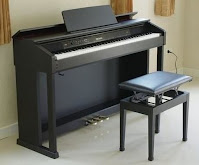











Just spent a good few hours in the local piano shop and it came down to the Casio AP620 or Yamaha YDVP240 or Yamaha CVP501.
Now the 501 did cost quite a bit more, but they were on 'special' so not a massive difference. However we decided that one was just a little too complex with the bells and whistles etc.
After a long play with the other two, we did try almost every piano in the stop about 15 in total, we plumped for the Yamaha YDVP240 as my wife liked the feel of the keys on this one more than the Casio. Sound wise it was perhaps hard to tell in the shop, but they both sounded good to me (a none player). This is my wifes first digital piano, and she was amazed at how they sounded.
Personally I liked the look of the Casio more, but looks are less important than how it feels to the player.
As the review above says you need to play these things and get a feel for what you like.
We went for the models with the extra features simply because they were a 'bit more fun'. The purely piano ones were nice, but within 5 mins of playing one of these models my wife already had backing tracks going and extra instruments blaring out.
We are in Australia and the YDPV240 ended up $200 more than the Casio, so not a huge difference.
I hope the new DGX650 upgrades include making the grand piano sound at least as good as the YPG625. The DGX640 piano sounds all have an unrealistic rapid decay on the piano sounds. Tweaking with reverb and DSP settings only makes it a rapid decay with more or less reverb.
The DGX650 will have the same grand piano sound as in the P105 which is a much better sound than in the DGX640